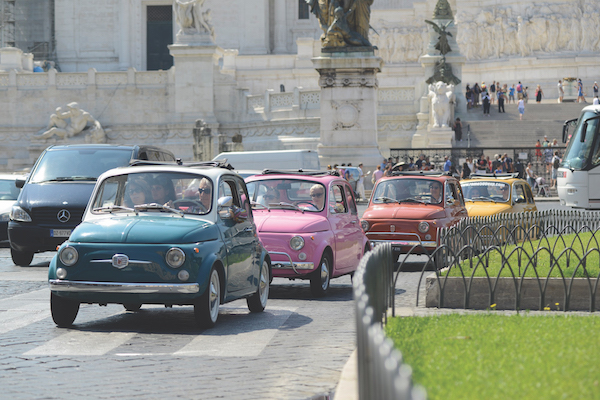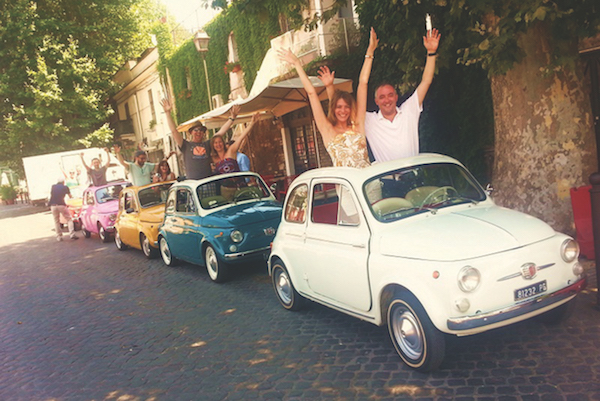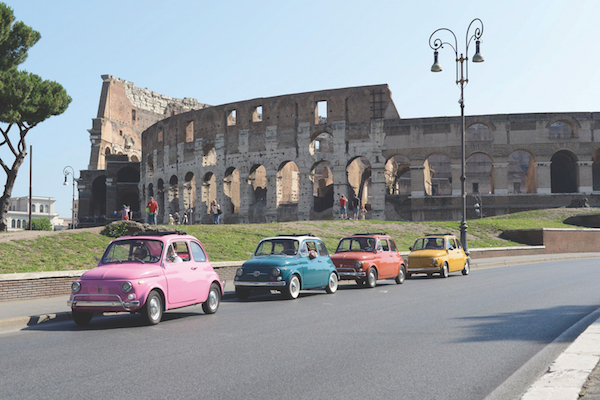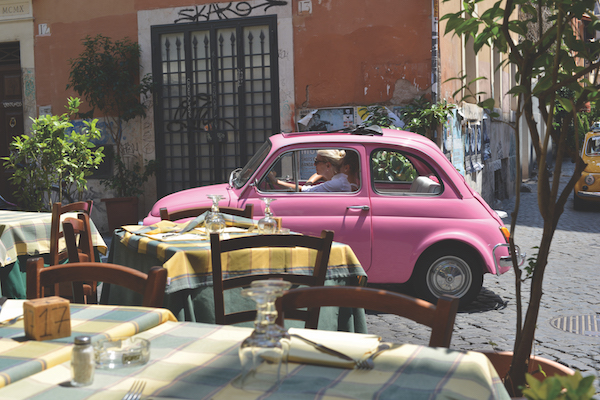Italy has given us many great cars, but there is one that is more iconic than any other. Mark Nicholls experienced a tour around Rome as a passenger in a classic Fiat 500…
The streets emit a cacophony of toots and hoots as our drivers whizz us around the centre of Rome. We’re jammed cosily into tiny Fiat 500s and our mini-convoy of red, pink and two-tone blue and cream cars cuts a head-turning swathe as we scamper through the back streets and past some of the city’s main sights. With a mix of brake, accelerator and horn, we weave through the traffic, cruising past the Vittorio Emanuele monument, along the banks of the Tiber and up the famed hills for panoramas across the skyline.
The way to go
For a whacky, whistle-stop tour of Rome, a Fiat 500 is absolutely the way to go. You will get to parts of the city that other, more modern, vehicles simply could not reach (think Mini Cooper, Michael Caine and The Italian Job). You feel like a celebrity, despite the car’s cramped interior. These 1970s originals of the classic Italian motor car are definitely A-list attention grabbers. At every turn people wave, smile and flash cameras at us. Others pause at their pasta and raise eyes from half-consumed dishes as we brush past street-side trattorie, wriggling through the narrowest of gaps. At each stop curious onlookers crowd around the adorable cars to take photographs or admire the cute little vehicles we are riding in. For a couple of hours or so, we weave our way through Saturday afternoon Rome traffic. The sun-roof is open, but I am snuggly tucked in the rear while my travelling companion and our driver Paolo enjoy marginally more space in the front. But squeezing into a Fiat 500 is a delight, and a great way to get a fresh perspective on the capital.
Into the city centre
We hooked up with Alvise di Giulio, who runs the tours, and fellow drivers Jacques and Paolo, and were soon whizzing away from the comfort of the modern A.Roma lifestyle hotel and into the city centre. Alvise has his own love affair with the Fiat 500s.
“For me, it is a way to bring together my passion for the Fiat 500 and my love of Rome and show them both off to people who visit our city,” he tells me. But it’s not just about the sightseeing. You feel the centre of attention for a few moments simply because the Fiat 500s love the streets of Rome – and Rome loves the 500s. With cars garaged close to the Colosseum, the Rome500 Experience offers a range of tours and delights in showcasing some of the more obscure, rather than mainstream, views and attractions of the city, such as with the popular three-hour ‘Seven Hidden Gems of Rome’ Tour.
Our journey took in the Colosseum and the Knights of Malta Square, Circus Maximus – the Ancient Roman chariot racing stadium that is now a public park but once held 150,000 spectators. We also head to the Orange Garden – the Giardino degli Aranci – or Parco Savello as it is also known on the Aventine Hill. The name of the garden comes from the bitter orange trees growing there and it extends over the area of an ancient fortress built near the Basilica of Santa Sabina by the Savelli family in the 13th century.
Gianicolo’s Terrace
The journey showcases the Pyramid of Cestius, near the Porta San Paolo and the Protestant Cemetery, before we sweep away to Gianicolo’s Terrace and arguably the finest view over Rome.
Gianicolo, or the Janiculum, is in the west of Rome and, though it is the second highest hill in the modern city environs, after Monte Mario, it is not strictly one of the fabled Seven Hills as it is outside the boundaries of the ancient city. That, however, does not detract from its appeal, and it offers perhaps the most impressive view over the Italian capital. We drew our convoy into a suitably prominent parking spot – after all, our cars were the real appeal and we were more than happy to pose with them – before taking in the view of central Rome with domes and bell towers and the marble white of the Vittorio Emanuele monument to the fore.
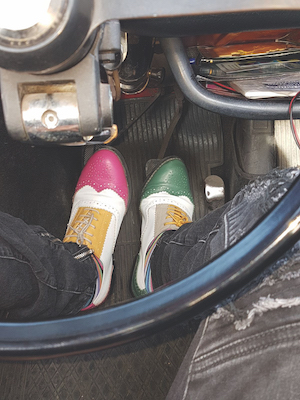 Sights on the Janiculum include the church of San Pietro in Montorio, on what was formerly thought to be the site of St Peter’s crucifixion, and a small shrine known as the Tempietto, marking the supposed precise place of his death. Other grand buildings nearby include foreign research institutions and diplomatic residences. This is also the site of a battle in 1849 between Garibaldi and French forces fighting to restore the temporal power of the Pope over Rome.
Sights on the Janiculum include the church of San Pietro in Montorio, on what was formerly thought to be the site of St Peter’s crucifixion, and a small shrine known as the Tempietto, marking the supposed precise place of his death. Other grand buildings nearby include foreign research institutions and diplomatic residences. This is also the site of a battle in 1849 between Garibaldi and French forces fighting to restore the temporal power of the Pope over Rome.
Several monuments to Garibaldi and those who fell in the wars of Italian independence are on the Janiculum. A cannon fires once a day at noon from the Janiculum in the direction of the Tiber as a time signal. This tradition goes back to December 1847, when the cannon of the Castel Sant’Angelo gave the sign to the surrounding bell towers to start ringing at midday. In 1904, the ritual was transferred to the Janiculum and continued until 1939. After a 20-year interruption, it was re-started on April 21, 1959, and continues to this day.
Alvise explains: “The ‘Seven Hidden Gems’ tour is our most popular tour. Our customers enjoy a magical mystery tour on board our cute Fiat 500s and discover a few hidden places.”
Other trips take in the Jewish Ghetto, shopping experiences and Rome by night, while a wine tasting tour covers all the main spots, ending up in a popular wine bar where a sommelier presents four Italian wines. And there is the paparazzi Fiat 500 experience with a cameraman taking photos at every opportunity, transforming passengers into mini celebs, all in the name of fun.
Narrow alleys
But it was when we submerged ourselves in the narrow alleys that the Fiats came into their own, nipping through back streets of tall shuttered apartments, trattorias and hidden courtyards. And while the Fiat 500s are about the experience, there is a healthy element of showmanship from Alvise and his drivers. After the tour, there’s always time to return to some of the major highlights of the city and visit other attractions such as the Spanish Steps, Trevi Fountain, the Vatican and St Peter’s, the Parthenon, or simply people watch in a café bar on the Piazza Navona.
From the dashing Fiats, our group eventually headed back to the A.Roma hotel to freshen up, relax and enjoy dinner in this modern suburban retreat. Our conversations were, of course, about the car tour and the experience with Alvise and his team adorning passengers with a series of props, big glasses and hats for a series of whacky photos that the drivers revel in taking to add an extra dimension to the tour and preserve some of the memories.
With plenty of laughter along the way, put simply, it is great fun, with Alvise having his 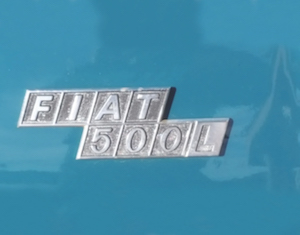 own ideas as to why the Fiat 500 tours are unique. “The Fiat 500 classic car is the only ‘smiling’ car,” he says. “They don’t look aggressive, naughty or posh. But our guides also engage with the participants; we take lots of pictures of our customers wearing funny props such as big, coloured circus glasses, wigs, and funny hats, and onlookers love our sparkling, coloured, joyful cars. They wave and smile at our convoys and take pictures of us.”
own ideas as to why the Fiat 500 tours are unique. “The Fiat 500 classic car is the only ‘smiling’ car,” he says. “They don’t look aggressive, naughty or posh. But our guides also engage with the participants; we take lots of pictures of our customers wearing funny props such as big, coloured circus glasses, wigs, and funny hats, and onlookers love our sparkling, coloured, joyful cars. They wave and smile at our convoys and take pictures of us.”
The Rome500 experience make passengers feel like celebs for a few hours. But really, we all know it’s the cars that are the real stars.
More information:
A.Roma Hotel
Mark Nicholls stayed at the A.Roma lifestyle hotel in the city’s suburbs. The Taiwan-based LDC Hotel Group has brought its 276 rooms up to date with elegant designs, an outdoor pool, large private gardens, dining, a spa, conference rooms, and international cuisine.
Rome500 experience
Chauffeured tours with the Rome500 Experience typically cost €340 for two people but there is a self-drive option too for the more adventurous.
For more accommodation and food inspiration take a look at our Rome travel guide.

